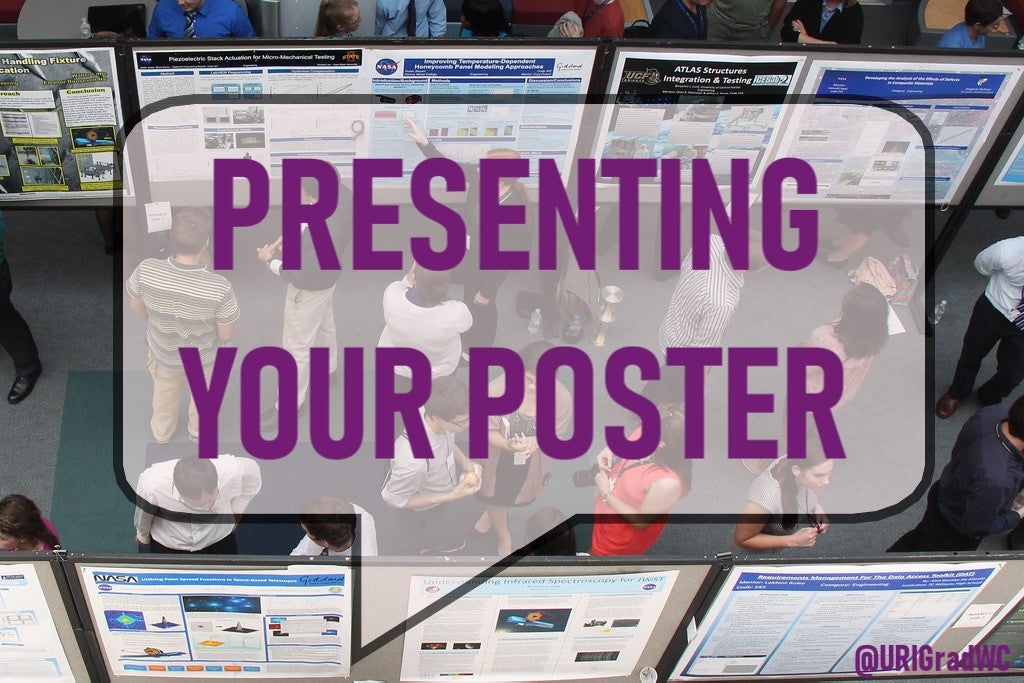Creating a poster is one challenge, but presenting a poster is another. Below you’ll find some helpful tips in presenting an effective poster that will help to engage your audience and connect to the maximum number of people.
- Bring business cards. Poster presentations are great networking opportunities. If your poster strikes up a good conversation, you may be asked for a business card so you can be reached in the future…potentially for a job opportunity!
- Know your audience. There are several types of people you may encounter at your poster.
- Some people will only skim over your poster and not ask any questions. Therefore, it is helpful to have a compelling title with major points written in a larger font to grab their attention. Having informative figures and graphs will also be best suited for this type of person.
- Some people may want to read your entire poster. Although you should refrain from using fully formed paragraphs, well-constructed bullet points and lists can be just as informative. Your audience should be able to understand what you did, how you did it, and what you found just by reading your poster.
- People may ask you to verbally describe your project. In this case, your poster will act as a visual aid and you will walk them through the steps of your project pointing out pictures, graphs, tables, etc on your poster as you explain. It is likely that you will encounter all of these types of people at a conference and you should be prepared for all of them.
- As the poster creator and presenter, you want to make sure your poster is visually ready for different audience types and that you are verbally prepared to explain your poster as well as answer questions. Also do not assume your audience is well-versed in your field therefore try to avoid jargon. You can always ask how familiar your audience is with your research area too.
- Create an elevator pitch. You should create a short speech (~2 minutes) that summarizes your poster. The speech should provide an overview of your research topic, what you found, and why it is important. The pitch helps to provide your audience with a short introduction about your research that hopefully leads to engaging questions and a closer look at your poster. The purpose of the pitch is to grab your audience’s attention and so, should be compelling and interesting.
- Create a story. After you’ve hooked your audience with your elevator pitch, make sure you can provide a more detailed explanation of your research. For this explanation, you should walk your audience through your poster, which will act as a visual aid. Create a compelling story. Make sure you include sufficient background information, explain your major findings, and describe the significance of your project. Try to tell your story in 10 minutes or less.
- Practice, Practice, Practice. The best way to become comfortable with your poster and talking about your poster is to practice. Rehearse what you plan to say with your lab mates, friends, or family. This will only make you come across more prepared, knowledgeable, and professional when you present your poster officially.
- Dress for success. Although you should dress professionally, you also want to make sure that you feel comfortable in what you are wearing. When you are comfortable you become more confident!
- Welcome constructive criticism. Be prepared for discussion and do not be defensive when faced with criticism. Criticism may lead to something you have not considered before and could be helpful to improve your project or future projects. Remember to thank your audience for visiting your poster and offering feedback.
The above information was adapted from Brian Pfohl and Greg Anderson from Bates College and Scientifica (https://www.scientifica.uk.com/neurowire/tips-for-presenting-your-scientific-poster-at-a-conference ). Prepared by Danielle Perry, GWC Writing Tutor.
Cover photo attribution: “500 interns – NASA poster session” by 13winds is licensed under CC BY 2.0

